PDF chapter test TRY NOW
In the last theory, we saw nutrition in unicellular organisms. In this theory, we will see nutrition in complex multicellular organisms like the human whose digestive system is complex. The human digestive system is responsible for the breakdown of complex food substances into constituent simpler substances that can be utilised by the cells of the body.
The human digestive system is composed of two main parts - the alimentary canal and the associated digestive glands.
Alimentary canal
The alimentary canal is a long tubular passage of mucous membrane and muscles which extends about \(8.3\) \(metre\) from the mouth to the anus. The alimentary canal composed of the following parts:
1. Buccal cavity or mouth
2. Pharynx
3. Oesophagus
4. Stomach
5. Small intestine
6. Large intestine
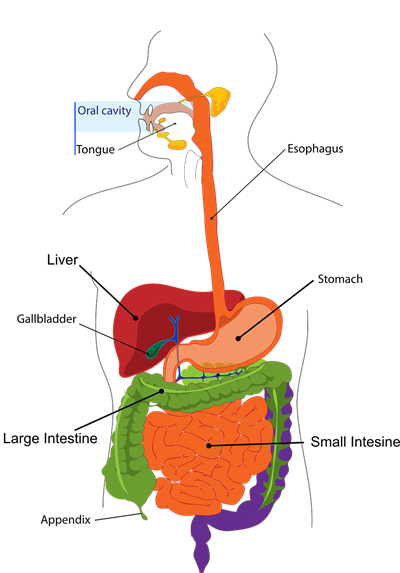
The parts of human digestive system
The associated digestive glands include:
- Salivary gland
- Gastric gland
- Liver
- Pancreas
Mouth
The human mouth consists of two parts that include the vestibule and the oral/buccal cavity. The buccal cavity is the interior part of the mouth which has the following parts:
1. Palate - It is the roof of the buccal cavity. The anterior part of the palate is called the hard palate whereas, the posterior part of the palate is smooth and called the soft palate. The uvula is the hinder free part of the soft palate, which hangs down freely as a flap.
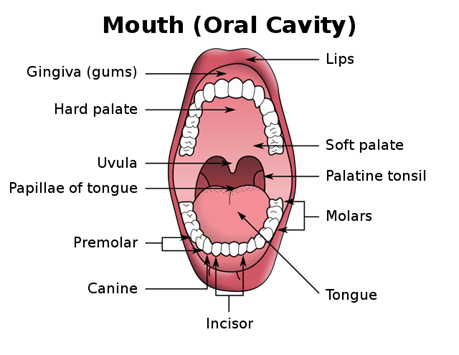
Parts of the mouth
2. Tongue - It is a muscular organ (contains voluntary muscles) covered with mucous membrane which forms the floor of the buccal cavity. The tongue is attached to the floor of the mouth by a connective tissue fold called lingual frenulum. It has gustatory receptors that aid in the perception of taste.
The tongue has four taste zones - sweet, salt, bitter and sour. It aids in the chewing and swallowing the food. The tongue also rolls and turns the food to ensure that saliva is adequately mixed with the food. It also helps in the process of speech.

Regions of the tongue for different tastes
3. Teeth - Humans have heterodont dentition (teeth differ in appearance throughout the mouth). Teeth in humans is diphyodont, i.e., have two sets of teeth - deciduous or milk teeth and permanent teeth.
Teeth are embedded in the sockets of the jawbones. There are four kinds of teeth:
- Incisors - specialized for cutting and biting food
- Canines - specialized for piercing and tearing food
- Premolars - specialized for crushing and coarse grinding food
- Molars - specialized for fine grinding of food
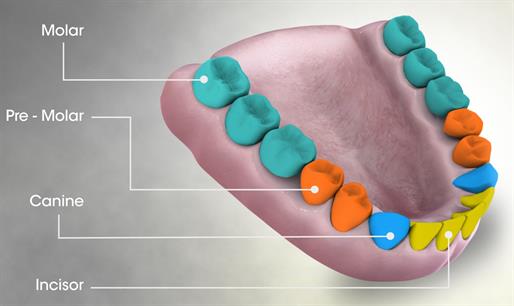
Types of teeth
Parts of the teeth
A tooth consists of three regions:
1. Crown - It projects above the gums. Crown allows the breakdown of food, which is protected by the tooth's enamel. Enamel is the hardest substance which covers the dentine (it's also the hardest material in the Kingdom Animalia.). Dentine is the hard, ivory-like substance that lines the pulp cavity.
2. Neck - Neck is surrounded by gum. It serves as a joint between the gum and the crown of the tooth.
3. Root - It is embedded in the bone. The root anchors the teeth. and allows the blood, nerve supply entry into the teeth.
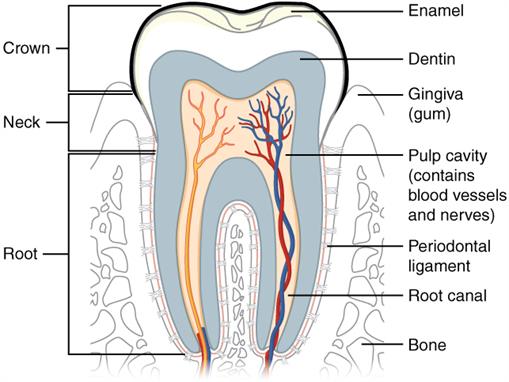
Tooth anatomy
Did you know what causes dental caries?
Tooth decay occurs when bacteria act on the sugars to produce acids that attack the tooth surface and demineralises the enamel.
Tooth decay begins when acids are produced by the bacteria that acts on sugars which soften and demineralises the enamel. Bacteria in the mouth creates acid through the oxidation of sugar present in food particles in the mouth.
Masses of bacterial cells grow together with the food particles that bind to the teeth to form dental plaque.
Since the plaque covers the teeth, saliva cannot neutralise the acid produced on the tooth surface. Thus, brushing teeth after ingestion of food removes the plaques before the bacteria produces acid. However, if untreated, microorganisms can invade the pulp that causes severe toothache, infection and inflammation.
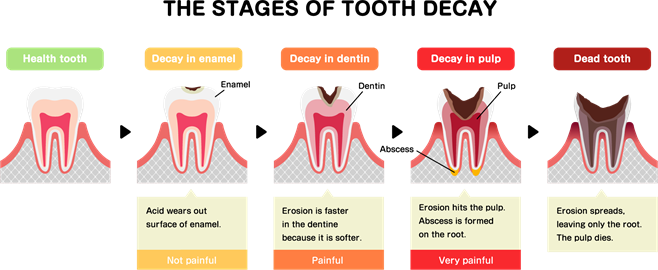
Tooth decay
How to prevent tooth decay?
1. Rinsing mouth thoroughly with clean water after each meal reduces the bacterial load.
2. Brushing teeth twice a day reduces the bacterial load and plaque.
3. Dental floss must be used to remove the trapped food particles.
4. Avoid using dirty fingers or unwashed objects in the mouth.
1. Rinsing mouth thoroughly with clean water after each meal reduces the bacterial load.
2. Brushing teeth twice a day reduces the bacterial load and plaque.
3. Dental floss must be used to remove the trapped food particles.
4. Avoid using dirty fingers or unwashed objects in the mouth.
Reference:
https://upload.wikimedia.org/wikipedia/commons/c/c3/Illu_mouth.svg
https://commons.wikimedia.org/wiki/File:3D_Medical_Animation_Still_Showing_Types_of_Teeth.jpg
